THIS FOOD WILL MAKE YOU BOOK HOLIDAYS IN CRETE EVERY YEAR
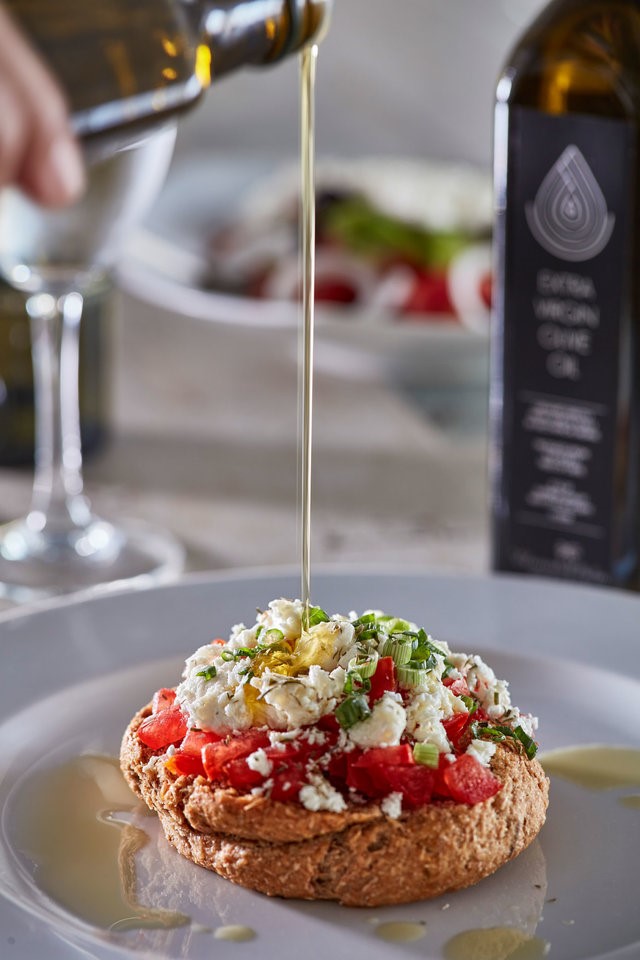
Dear guests, our mission today is to decipher a menu of a taverna in Crete and what a delicious mission that is! Our aim is to encourage you to order some must-try dishes and make your holidays in Crete a more authentic experience. So, whether you are ordering food from the in-room menu of your private pool villa, the restaurant of a beachside hotel in elounda, or your nearby taverna, we’ll help you do it like a true local.
Before we get into listing our favorite food from Crete, we would like to share some thoughts and data. For those that are repeat visitors to Crete island, we hope you will agree that one of the greatest things you will experience on your holidays in Crete is Cretan diet. Food is a main characteristic of the island’s tradition and so is food throughout Greece. However, Crete’s gastronomy is extraordinary, some dishes cannot be found in other parts of Greece and if you try it you will want to come back for holidays in Crete every year!
Did you know that the World Ηealth Organization characterizes Cretan diet as one of the healthiest and most sustainable diets in the world? Some 100 year old grannies that live in villages of Crete will agree! Cretans became a case study because of their health and longevity in comparison to other civilisations. Some will support that the gastronomy of Crete is considered the birthplace of the Mediterranean diet.
In Elounda Palm Hotel we honor Cretan gastronomy through our buffet and poolside restaurant but also in-room menu, for breakfast, lunch and dinner. Our breakfast buffet has a certificate of Cretan Gastronomy and includes sweet and savory Cretan dishes such as “mizithropitakia”, “kaltsounia”, Cretan omelette, goat’s milk, yoghurt, cheese and plenty of vegetables, olives, olive oil and dry barley rusk “dacos”bread. Here you will have the opportunity to start your day with authentic traditional ‘superfood’ dishes.
So without further ado, here’s a list of our top choices to try on your holidays in Elounda:
“Chorta”
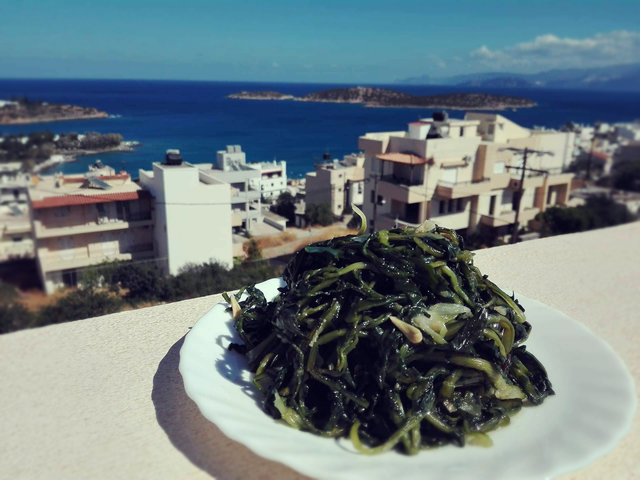
Picture courtesy of Maria Metochianaki
In Greek, all the greeneries that can be boiled are called “Chorta” and they differ from season to season. “Chorta” was the main food for the old people in Cretan villages, because it was easy to collect from the mountains (no cultivation needed). They are wild plants which grow on the mountains and the only way to find them is during a good hike. All you need is a knife, a plastic bag and a good “yiayia” granny to show you the ones that are edible (because not all “Chorta” are suitable to eat nor taste the same)! You can try them boiled or cooked, “tsigariasta” in the pan or sometimes even raw. Some types of “Chorta” are: “Vlita”, “Tsimoulia”, “Stamnagathi”, “Seskoula”, “Vrouves”.
Tips
You can order “Chorta” nearly in every taverna (sometimes they are not on the menu).
If you feel adventurous, you can try collect them on your own. Don’t forget to get tips from a local though…
“Skioufichta”
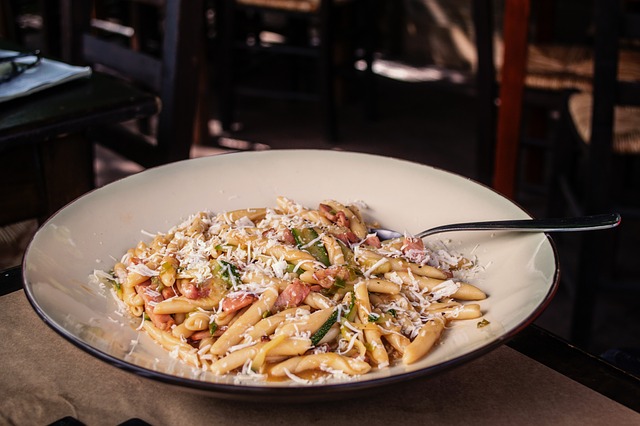
Picture by DanaTentis via Pixabay
“Skioufichta” or “tsi heras” (i.e. ‘by hand’) are Crete’s version of hand-made pasta. We don’t feel that pasta needs any special introduction; it’s hard not to like pasta after all! You will find “skioufichta” in many different versions. The most traditional way to have them are boiled in bone broth and served with dry “anthotiro” cheese. You will find “Skioufichta” mainly in east Crete.
Tip:
When in the Elounda Palm hotel try Vassili’s (our chef’s) version of “skioufichta” with mushrooms and local soft cheese for lunch. Yum!
Goat Meat “Psito”,” Antikristo”, “Tsigariasto” or “Frikase”
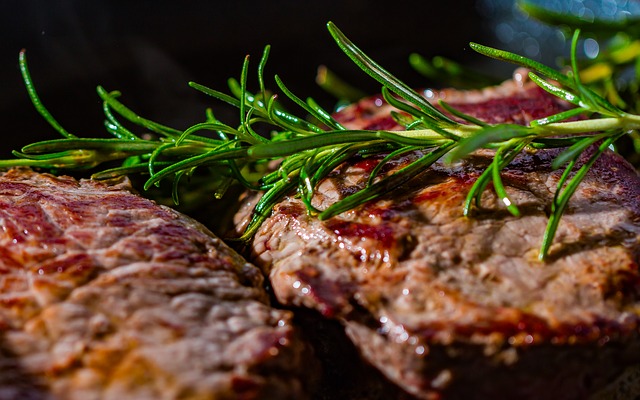
Picture by Divily via pixabay
Let us take the opportunity to pay tribute to the very ‘misunderstood’ goat and lamb, especially for those guests who are put off by the assumption that a smelly dish will arrive on the table! Indeed, the goat is not on the every day menu of a Cretan home, but it’s a MUST on every festive occasion because of its delicious taste and skill required to create the perfect goat. So if a locally sourced, slow cooked goat is served, don’t miss the opportunity to try it, please!
Tip:
The goat comes in many forms. The most authentic recipes are:
“Tsigariasto” is slow cooked in olive oil, normally light in texture and taste.
“Antikristo” is the Cretan form of the Argentinian ‘asado’, placed in special sticks and cooked around a fire.
“Psito” is the most usual version, cooked in the oven with herbs and potatoes.
“Frikase” is the combination of goat and “Chorta”.
Cretan Cheese
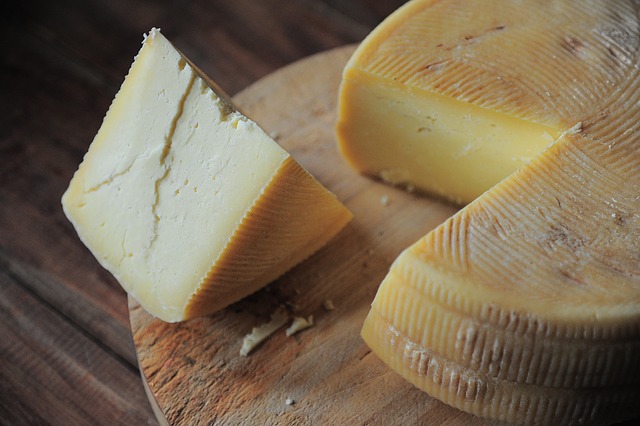
Picture by AlexKlen via pixabay
Did you know that the base of the economy of Crete is agriculture? Even in today’s modern world you will find old-school shepherds on the mountains of the island of Crete, surrounded by goats! Their mission is one: to breed goats,sheep (geeps) and produce meat and milk products. People from Crete love their cheese! The most popular varieties are “Kefalotiri”, “Mizithra” , “Graviera” ,“Anthotiro” and “Xigalo”.
Tip:
You can visit the store “To Mpakaliko tou Lagou” in Agios Nikolaos and Neapoli to discover the cheeses of the area. If you have the chance to buy cheese directly from a shepherd, seize the day!
“Hochli boubouristi” aka Escargot
If you are French, you probably relate with our passion for “hochli”. Otherwise, eating snails may not sound as the most appealing choice on the menu. Still, this is one of the most authentic and traditional dishes in the cuisine of Crete, so we do encourage you to try. Trying the sauce by dipping a piece of bread in it is a good starting point. If you like the taste then you can move on to the real thing! There are versions of this Cretan dish. “Boubouristi” are snails on the pan, sizzled in wine and rosemary. Another popular recipe is escargot in the pot with “xinochondro” (Crete’s version of couscous ).
Tip:
The collection of snails is a traditional ‘hobby’ of Cretans, especially after a rainy day (after all, snails love the water). Today’s “hochli” are usually grown in snail farms, however the traditional way was to hike on the mountains and collect ‘free range’ “hochli”! We all have a picture of our parents, years back, leaving the house all excited with a torch on a rainy night going snail hunting…
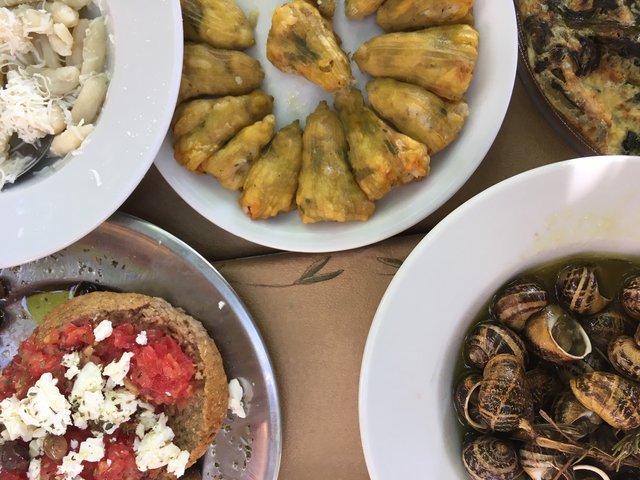
“Dolmadakia” or “Kolokithoanthi”
You’ve probably heard of “dolmadakia” before. “Dolmadakia” are essentially stuffed vine leaves with rice and herbs, sometimes with rice and minced meat. What’s special about this recipe in Crete is the version of “dolmadakia” wrapped in zucchini flowers instead of vine leaves, also known as “Kolokithoanthi”. Both vine leaves and flowers are collected only a specific time of the year and it is not easy to find them on the market.That’s probably why zucchini flowers sell for GBP 1 a piece in London’s Harrods store!!!
Tip:
Try them with yoghurt and a lot of lemon.
Cretan omelette
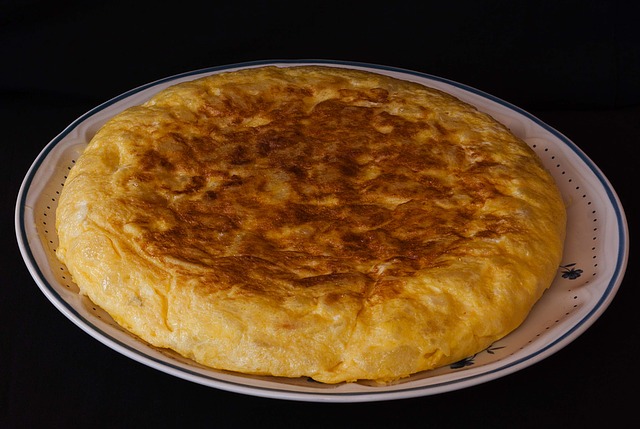
Picture by Schnauzer via Pixabay
Omelettes are made everywhere in the world… but not the Cretan way. They are very thick, usually made with fried potatoes, “apaki” (meat) or “chorta”. Cretans like vegetables with their omelette and so will you, after trying the local version.
Tip:
It might sound odd but try the omelette with a side dip of sheep’s yoghurt.
“Gamopilafo”
“Gamopilafo” translates to Greek as ‘the wedding pilaf’; that’s because its rich filling texture and taste are the perfect treat for a special occasion. So if you’re on a honeymoon in Crete, you deserve to treat yourself with a good “gamopilafo”! The essential ingredient of a “gamopilafo”, besides the obvious pilaf rice, is goat broth. Till nowadays, the “gamipilafo” remains a staple of every Cretan wedding, so if you’re invited to a wedding in Crete, don’t skip this dish!
Tip: Enjoy it with grated “mizithra” on top!
“Kaltsounia”
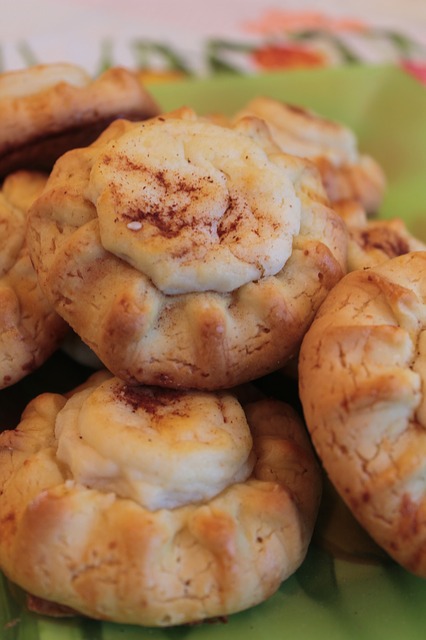
Picture by Kuzcomerlin via Pixabay
Warning: once you try one you will want to eat a whole box! Those little pies, stuffed with sweet “mizithra” cheese and drizzled with cinnamon are ‘to die for’. “Kaltsounia” were usually prepared only during Greek Easter time. However, with the years (and more mizithra on the table) those darlings are served as a dessert and are a perfect combination with a sip of raki.
Tip:
Often you will find “kaltsounia” on the Elounda Palm hotel’s morning buffet- try them!
“Sfakianes Pites” or “Mizithropites”
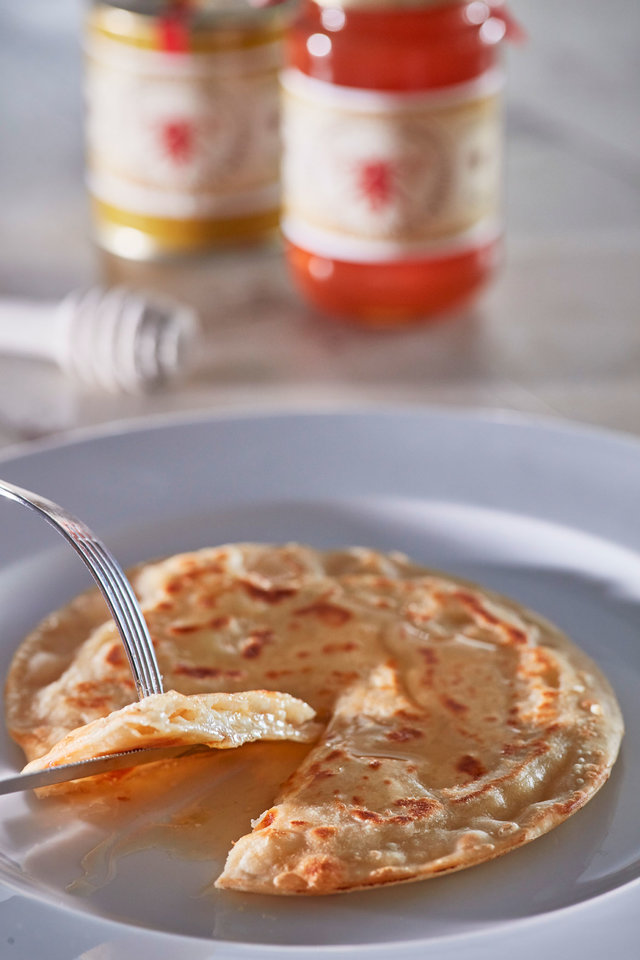
Photo property of Elounda Palm hotel
The “kaltsounia” recipe is not the only dessert that’s made of cheese. Depending in which part of Crete you are, you will find a version of this dish which are essentially thin, fried pies filled with sour “Mizithra” cheese and served with honey. The recipe has two names, so depending whether you are on the west or east part of Crete island you will order them as “Sfakianes pites” or “Mizithropites”, respectively.
Tip:
“Mizithropites” make a perfect breakfast, snack and dessert so feel free to order them any time of the day, guilt-free!
“Dakos”
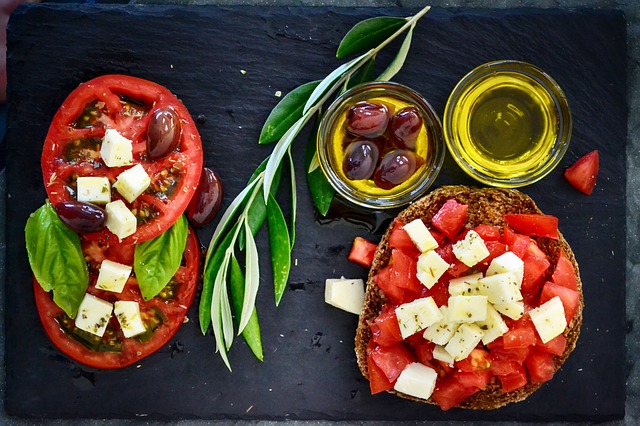
Picture by DanaTentis via Pixabay
We’ve left the most popular Cretan recipe for last, the “dacos” dried rusk served with tomato (chopped or blended), any type of white goat cheese (“feta” or “mizithra”), oregano and plenty of extra virgin olive oil. You will find many varieties of dacos rusk. Some are made of wholegrain wheat and others also include barley; this means that some “dacos” may be hard on your teeth so, before taking a bite on your own, you may want to soak the rusk in water for a few seconds! Commercial dacos is usually teeth-friendly
Tip:
If you want to do it like a local, dacos is the perfect snack, lunch or dinner when you want to keep it light or accompany your cold beer on a hot summer day by the Elounda Palm Hotel’s pool!

So there you have it dear guests.The gastronomy of Crete is a high plant based diet, with loads of fruit, vegetables and dairy products. If you ask us, we feel that the secret sauce behind the delicious flavors are the pure, good quality ingredients. Greens fresh from the gardens and the fields of Crete, extra virgin olive oil, honey, nuts, herbs all put an authentic touch to the flavors and aromas of every dish. So be adventurous and explore the Cretan gastronomy; you will be rewarded in every bite!
For guests who want to explore the gastronomy of Crete (even try make some hand-made dolmadakia) you will find here an excellent selection of tours and workshops, ready to book.
Share with us your gastronomic experience from your holidays in Crete!
What’s your favorite dish?
